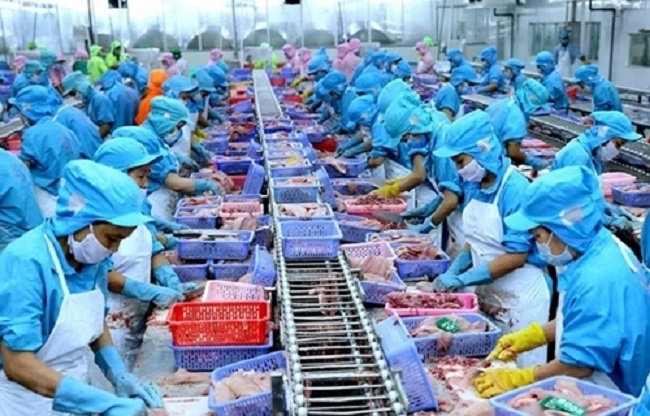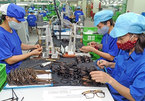 |
|
|
These are the initial signs showing that Vietnam’s economy is gradually recovering and regaining its growth momentum.
GDP growth target of over 5% is feasible
For the first time since the beginning of 2020, many bright spots have begun to return on Vietnam’s socio-economic panorama.
Specifically, the country’s industrial production has recorded positive signs as the index of industrial production (IIP) in May rose 11.2% compared to the previous month.
Business registration has become vibrant again, with the establishment of an additional 10,700 businesses, up 36.1% in the number of enterprises, up 20.1% in terms of registered capital and up 27% regarding the number of workers compared with the April figures. The number of businesses resuming operations also reported an increase, while the number of enterprises suspending their operations for a definite time saw a double-digit decrease.
In addition, the signs of economic recovery have been reflected through a strong increase in the Manufacturing Purchasing Managers’ Index (PMI). Vietnam’s PMI in May rose by 10 points to 42.7, compared to the figure of 32.7 points in April.
Notably, the people’s purchase of goods and consumption also showed signs of surging back, with retail sales of consumer goods and services increasing by nearly 27% over the previous month. In particular, revenue from accommodation and catering services expanded by nearly 96%, while tourism revenue grew by 780%. Import-export turnover also reported a month-on-month increase.
Inspired by important achievements in its fight against the COVID-19 pandemic, Vietnam has now been focusing on restarting the economy, striving for a GDP growth rate of over 5% in 2020 with five spearheads, including attracting foreign direct investment (FDI), boosting exports, accelerating public investment, attracting investment from the private sector, and facilitating domestic consumption.
Dr. Can Van Luc, chief economic export at the Bank for Investment and Development of Vietnam (BIDV), said that the growth target of over 5% in 2020 is feasible for the Vietnamese economy, and that GDP growth is much likely to bounce back strongly next year. The resilience of the economy depends on three factors: the ability to control the pandemic, the effectiveness of Government support packages, and international cooperation in combating the disease and reviving the global economy.
Supporting small and medium-sized enterprises
According to Dr. Can Van Luc, it is necessary to promote new growth engines to offset the deficiencies caused by COVID-19. New growth drivers include the private economic sector, FDI attraction, domestic stimuli, substantive reform of administrative procedures, and restructuring the economy to enhance its resilience to external shocks. In particular, administrative procedural reform is playing an extremely important role at the present moment.
In addition, the Government needs to identify the economic sectors directly affected by the pandemic to apply proper support solutions for the right subjects, thus helping to rejuvenate the economy, he said.
Nguyen Tri Hieu, a finance-banking expert, commented: “Entering the stage of economic recovery, many businesses have resumed operations, but there remain many micro and small-sized enterprises (SMEs) that cannot operate fully yet. In particular, the number of businesses leaving the market has increased dramatically. The Government should take stronger measures aimed at small and medium-sized enterprises who have difficulty in accessing the VND300 trillion (US$13.03 billion) credit aid package.”
In fact, the size of this support package has reached nearly VND 700 trillion (US$30.4 billion). This source of capital, however, has been mobilised from commercial banks, not the state budget, so it is absolutely not an economic bailout package with low interest rates and loosened lending conditions for SMEs to approach. Banks are wary of making loans to weakening businesses in order to avoid the risk of bad debt.
In addition, the fiscal support package worth VND180 trillion (US$7.81 billion) has not yet worked adequately for SMEs in difficulty, because the outbreak of the disease has forced them to shrink their business operations and earn no profit in order to qualify for tax incentives. To support SMEs to resume production, the Government needs a separate support package for these subjects through credit guarantee funds to provide capital for banks to make loans.
Currently, the guarantee mechanism is available, but the results of credit guarantee activities at the funds have still remained limited in recent times. The combined guarantee revenue from new funds is only about VND4 trillion (US$173.72 million), a very small figure compared to the economy’s total credit scale of approximately VND8.5 quadrillion (US$369.15 billion). In addition, loose and ineffective coordination between a number of credit guarantee funds and commercial banks is also a reason why SMEs have not been able to access this resource.
“It is necessary to restructure credit guarantee funds into central credit funds and increase the charter capital for these funds. This is an important channel to help SMEs access loans to restore their business production at present as well as in the long term. Through guarantee activities, capital from credit funds will contribute to improving the financial capacity of enterprises, better supporting their production activities, enhancing their competitiveness, creating more jobs, and increasing incomes for workers,” expert Nguyen Tri Hieu said. Nhan Dan

Vietnam needs to boost public spending for economic recovery
In order to revive an economy left undermined by the fight against the coronavirus outbreak, what matters most to Vietnam is taking advantage of its current potential and seizing new opportunities to bolster growth.

Vietnamese retail to be at heart of post-pandemic recovery
If the Vietnamese economy is able to successfully enjoy a rapid economic recovery following the conclusion of the novel coronavirus (COVID-19) pandemic, the retail industry will be one of the driving factors in this revival process.